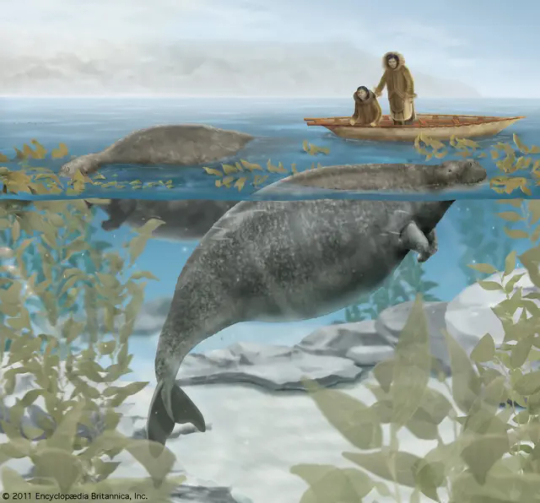#Steller’s Sea Cow
Text
First Wet Beast Wednesday of the year! So without further ado…
All animals will behave as they would in the wild (or as close to for all extinct species) except that your defender(s) will not cause friendly fire. However, any attempt to attack and/or eat your defender(s) will cause them to turn on you.
#poll#wet beast wednesday#invertibrates#cnidarians#jellyfish#crustaceans#lobster#radiodonts#fish#sharks#deep sea fish#cetaceans#whales#sirenia#Steller’s sea cow#extinct species#marine life#marine biology
25 notes
·
View notes
Text
steller’s sea cows are so big dude. you dont even get how big they are. they are big as a kitchen
1 note
·
View note
Text

Sunlemon - LOST ANIMALS
#plush#plushie#plushies#plushblr#plushcore#toycore#soft toy#stuffed animals#sunlemon#lost animals#extinct animals#mammoth#steller's sea cow#dodo#japanese wolf#great auk#plush: prehistoric#plush: pachyderm#marine mammals#plush: bird#plush: wolf#plush: canine
2K notes
·
View notes
Text

zoology joke
3K notes
·
View notes
Text
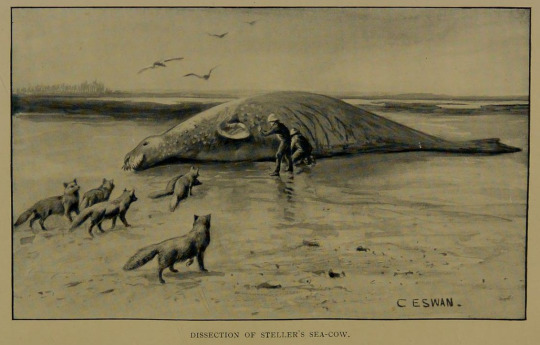
Wild Animals of Yesterday & To-Day. Written by Frank Finn. Illustrated by Cuthbert Edmund Swan. 1913.
Internet Archive
#recently extinct#sea cows#steller's sea cows#canines#foxes#arctic foxes#animal death#Cuthbert Edmund Swan
233 notes
·
View notes
Text

Steller's sea cow - a recently extinct giant sirenian, related to modern dugongs and manatees. They went extinct in XVIII century, but their exctinction wasn't just because of europeans, we know that the last populations near Kamchatka were already on the brink of exctinction.

These huge animals could reach 9 metres in length and weight 10 tonnes, making them the largest aquatic non-cetacean mammal we know. They were algae eaters, feeding on kelp. Unlike modern sirenians, they didn't have teeth and used two keratin plates in their mouths for chewing.
After feeding, according to Steller they'd lie on their backs and nap. Steller also observed an interesting mutualistic behaviour between sea cows and gulls (probably slaty-backed gulls), as these birds would eat parasites from the sea cow's back, like oxpeckers and rhinos.

The slaty-backed gull is one of the seabirds native to areas where sea cows used to live, and while we can't be sure which species of seabird fed on parasites of these large mammals, the opportunistic nature of seagulls makes them good contenders for the spot.

Despite their appearance, sea cows weren't stupid animals, they lived in large herds, looked after their young and were probably monogamous. Steller observed that they kept their calves in the middle of the herd or near the shore. This could have been caused by their predators.

Killer whales, specifically Bigg's killer whales, which are known to hunt other mammals, are the most likely predators of Steller's sea cow, apart from humans. While they might have trouble killing a large cow, especially in a herd, a small calf might be a meal worth the risk.

#3d#steller's sea cow#sirenian#sea cow#killer whale#orca#seagull#blender#lowpoly#paleoart#paleontology#nature#animals
72 notes
·
View notes
Text

Cryptid of the Day: Steller’s Sea Cow
Description: The Steller Sea Cow is one of many fantastic creatures that went extinct through overhunting. However, since its extinction, there have been many people who claimed to have seen the animal. The most recent sighting occurred in 1976 off the coast of Anapkinskaya Bay.
162 notes
·
View notes
Photo


Steller’s sea cow Hydrodamalis gigas
The Finnish Museum of Natural History, Helsinki, Finland
160 notes
·
View notes
Photo

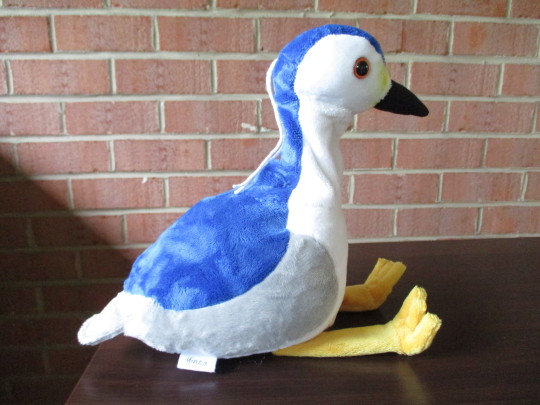






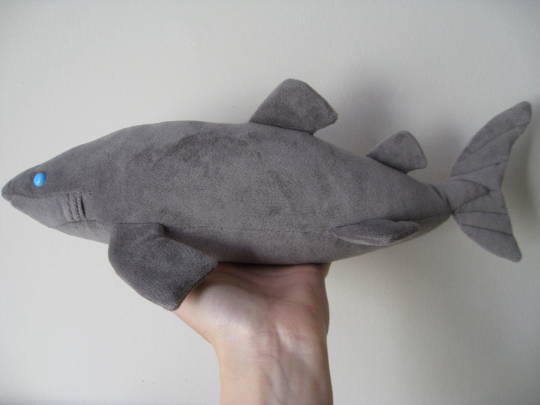

Man, I am... real bad at remembering to share plush work on here. Here’s just a dump of various custom orders I’ve made over the past while that I never thought to upload. Mostly birds, since that is what I have inadvertantly made myself known for.
[Image Description: A series of photos of various handmade plushies: a set of five pigeons, a black-crowned night heron with a retractable neck, a blue jay, a white cockatoo, a meadowlark, a common grackle, a greenland shark, and a steller’s sea cow. /end ID]
#birds#plushies#pigeons#herons#blue jays#cockatoos#meadowlarks#grackles#greenland shark#steller's sea cow#yinza's crafts
140 notes
·
View notes
Text

Various objects carved from "mermaid ivory," from the private collection of professor Lorelei Crerar. [x]
Manatees and dugongs are protected species, but because the Steller's sea cow has been extinct for over 200 years, trade in their bones is actually legal under the Endangered Species Act and related international laws.
Steller's sea cow bones are sometimes called "mermaid ivory," although this nickname is sometimes used for walrus bones as well. When tested, some of Crerar's collection came back containing whale or dolphin DNA, but some were genuine Steller's sea cow bones from a previously unknown population.
101 notes
·
View notes
Text
Everyday i wake up and think about stellers sea cow and cry a little bit
6 notes
·
View notes
Text

Mermay 2024 Day 11 - Cowboy
#art#auri draws#drawing#artist#artists on tumblr#merfolk#mermay 2024#mermaid#original art#steller's sea cow#merperson#merman
3 notes
·
View notes
Text
It's sad to me, how few people up here know we used to have our own sea cow. And yeah, they went extinct in the 1760s, and they're a more obscure one, but it's still sad.
3 notes
·
View notes
Photo
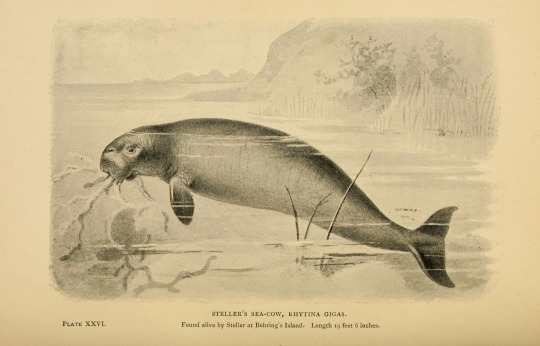
An illustration of a Steller’s sea cow from “Extinct Monsters: A Popular Account of Some of the Larger Forms of Ancient Animal Life” (1896). First described by Georg Wilhelm Steller in 1741, overhunting would drive the species to extinction less than three decades later. [ x ]
27 notes
·
View notes
Note
for the ask game: CORAL just for u bestie
[through tears] thank u
coral: an animal you wish hadn't gone extinct
i mean. i get sad thinking about any animal going extinct but i really want to talk about steller's sea cow

steller's sea cow was a sirenian (same family as manatees and dugongs) example of ice age megafauna. it outlived other ice age critters such as sabre-tooth cats and giant sloths, surviving all the way up to the 18th century. unlike its sirenian cousins, steller's sea cows lived in the icy waters of the bering strait; historical record only mentions them around the commander islands, but there is archaeological evidence that they hung out around the aleutian archipelago a thousand years ago, give or take (altho there are maybe some issues with radiocarbon dating and classification? idk i am not a scientist i am an idiot with wikipedia)
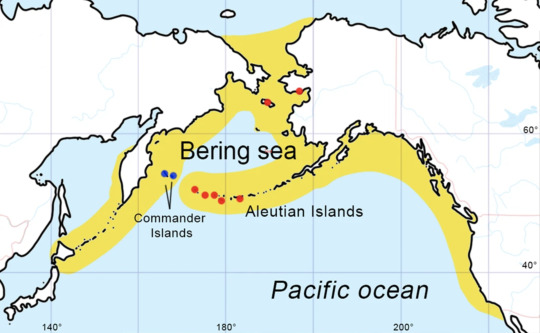
(yellow is their prehistoric range, blue is historical, and red is for archaeological evidence)
they were well-evolved for their environment, with 10 cm of thick blubber, dense bones, a transparent third eyelid, and no teeth. they ate exclusively seaweed and were apparently docile. they lived in small family groups and were monogamous. that they managed to survive so long is likely attributed to a lack of human contact*
*contact with white people.
steller's sea cow was first recorded in western science in 1741 by german scientist georg wilhem steller. steller was part of the great northern expedition/second kamchatka expedition, led by vitus bering for whom the bering sea is named. the expedition was shipwrecked for a year on its return journey from alaska, and it was then that steller's sea cow was first discovered, named, and researched by western scientists.
as i said before, they were docile & friendly animals without any real way of defending themselves. they were also positively buoyant, which made them difficult for killer whales to drown, but easy prey for hungry, curious humans. the population had been decreasing in the millennia since the ice age, and by the time steller and the rest of the crew first encountered them, there were only a couple thousand remaining at most.
their meat apparently tasted like corned beef, their fat like almond oil; their milk was turned into butter, and their hide into shoes and belts. in short, they were profitable, easy targets for hunters, fur traders, and nearby sailors.
other environmental factors contributed to their demise, but increased human contact could not have helped. in 1768, 27 years after they were first discovered, steller's sea cow was declared extinct. there were alleged sightings in the years after they were declared extinct, but there are no sea cows in the bering sea today, and there haven't been for over 200 years.
if i think about steller's sea cow--twice the size of a manatee, gentle and loyal with no means of defence, and hunted to extinction within three decades of formal discovery--i become blinded by tears and holy rage. thanks for coming to my ted talk, there's a solid article going more into the science from the atlantic.

#rori thank u for enabling my mini essay on steller's sea cow#there's a specimen in the museum of natural history in london if anyone wants to say hello to it. blow it a kiss from me <3#i learned about these guys from icebound by andrea pitzer which i otherwise found confused and lethargic#rorindiel#answered#there are many names in history#long post#the kit nedlittle guarantee that 90% of asks will be answered with minimum three paragraphs. apparently
21 notes
·
View notes

